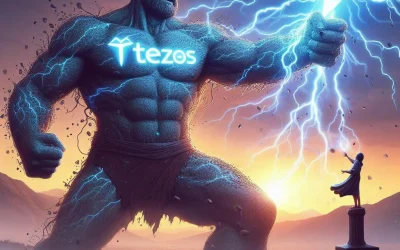Liquid Proof-of-stake: Why Tezos is ahead of the curve

Key takeaways
- Tezos uses a variant of the delegated proof-of-stake protocol, called liquid proof of stake
- Tezos offers the opportunity to anyone to become a block validator (Baker)
- Tezos is touted to be one of the most efficient and technically innovative platforms in the space
As blockchain technology and cryptocurrencies went through the early frenzied phase to enter a subtle, mature growth period, developers and technology leaders realized one of the biggest setbacks of cryptocurrencies: Proof of Work (PoW).
Proof of Work relies on computational work to solve challenges such as double-spending, but it’s slow, inefficient, and requires a high initial setup cost to run basic operations.
That’s when the Proof of Stake (PoS) consensus algorithm presented a better, energy-efficient way to mine (bake, validate, create) blocks.
Instead of engaging in computation-intensive mining, validators or bakers are selected at random to create blocks.
Among blockchain projects using PoS, Tezos is touted to be one of the most efficient and technically sound platforms.
This post will analyze why Tezos is ahead of its competition when using PoS for consensus.

Tezos: Liquid Proof-of-Stake (Different from Delegated PoS)
Tezos uses a variant of the delegated proof-of-stake protocol, called liquid proof of stake.
The process of mining or validating is called baking in Tezos.
The algorithm chooses a baker for creating a block from a group of eligible nodes (bakers).
Bakers with higher stakes and reputation are more likely to be picked up from the pool.
The baker creates a block, which is then sent to 32 other nodes from the bakers’ pool for attestation. If most bakers attest the block as good, it becomes a part of the Tezos blockchain.
Baker receives rewards for adding a block, whereas other nodes receive rewards for attesting the block.
In case other nodes identify the block as bad, they attest it as a bad block, and the block is rejected. The chosen baker loses a portion of his initial stake as a penalty.
3 Factors that Help Tezos Stand Out
- A vast pool of bakers (validators): One of the primary reasons why Tezos excels with its liquid PoS protocol is an unlimited pool of bakers. Anyone can become a baker with a stake of 1 roll or higher (8,000 XTZ), although a higher stake boosts chances of being selected for baking.
- Simple delegation of staking rights: XTZ token holders can delegate their tokens to a baker for earning staking rewards. Token holders do not have to share their ownership rights or lock their tokens to participate in the staking process.
- Protection against double-spending, nothing-at-stake: If a node finds double-spending by a baker, they can report the same with proof in the coming cycles, preventing malicious behavior from bakers. Similarly, bakers have to lock a portion of their stake to participate in the block creation process, eliminating the nothing-at-stake problem. The same applies to attesters, who might lose a portion of their locked tokens when acting maliciously.
Smartlink utilizes Tezos as the underlying platform for its online payment solutions and escrow services.
If you want to know more about Smartlink and the possibilities that are opened up for the new economy, have a look here.
Share this article

Sign up for our newsletter
Popular articles
Happy New Year 2025 from the Smartlink Team!
Trust-as-a-Service for the global marketplace Summary 2024 Recap: Major Milestones Etherlink Smart Rollup & Node Tezos Etherlink Mainnet Deployments Collaboration with Nomadic Labs Navigating a Challenging Market Etherlink: A Game Changer for 2025 Looking Ahead to...
Demystifying Escrow Payment: A Comprehensive Guide
Trust-as-a-Service for the global marketplace 🔎 Key takeaways Exploring the Benefits of Escrow Services in Crypto Transactions Maximizing Flexibility with Multi-Currency Escrow Solutions Future-Proofing Financial Transactions with Smartlink Innovation FAQ -...
Etherlink x Smartlink: Bridging Blockchain Efficiency
Trust-as-a-Service for the global marketplace 🔎 Summary Blockchain Efficiency with Etherlink x Smartlink Integration Etherlink: Affordable and Speedy Transactions on Tezos Leveraging Etherlink for Reduced Fees and Decentralization Advantages Through Etherlink...







